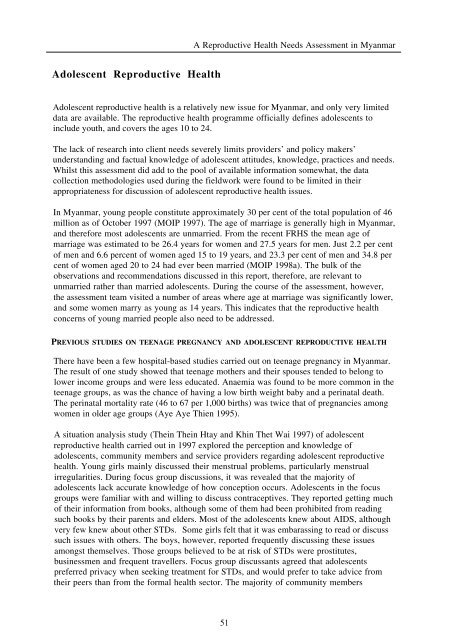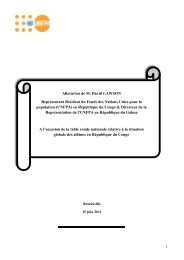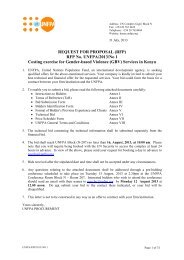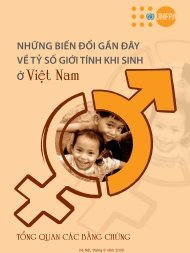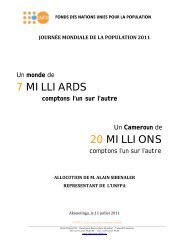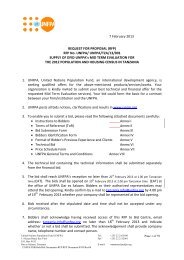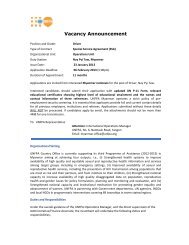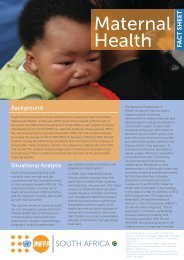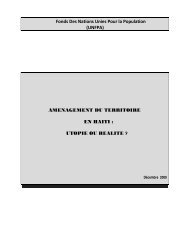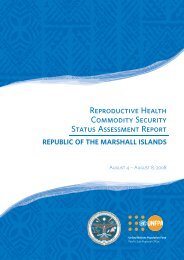A reproductive health needs assessment in Myanmar
A reproductive health needs assessment in Myanmar
A reproductive health needs assessment in Myanmar
You also want an ePaper? Increase the reach of your titles
YUMPU automatically turns print PDFs into web optimized ePapers that Google loves.
A Reproductive Health Needs Assessment <strong>in</strong> <strong>Myanmar</strong><br />
Adolescent Reproductive Health<br />
Adolescent <strong>reproductive</strong> <strong>health</strong> is a relatively new issue for <strong>Myanmar</strong>, and only very limited<br />
data are available. The <strong>reproductive</strong> <strong>health</strong> programme officially def<strong>in</strong>es adolescents to<br />
<strong>in</strong>clude youth, and covers the ages 10 to 24.<br />
The lack of research <strong>in</strong>to client <strong>needs</strong> severely limits providers’ and policy makers’<br />
understand<strong>in</strong>g and factual knowledge of adolescent attitudes, knowledge, practices and <strong>needs</strong>.<br />
Whilst this <strong>assessment</strong> did add to the pool of available <strong>in</strong>formation somewhat, the data<br />
collection methodologies used dur<strong>in</strong>g the fieldwork were found to be limited <strong>in</strong> their<br />
appropriateness for discussion of adolescent <strong>reproductive</strong> <strong>health</strong> issues.<br />
In <strong>Myanmar</strong>, young people constitute approximately 30 per cent of the total population of 46<br />
million as of October 1997 (MOIP 1997). The age of marriage is generally high <strong>in</strong> <strong>Myanmar</strong>,<br />
and therefore most adolescents are unmarried. From the recent FRHS the mean age of<br />
marriage was estimated to be 26.4 years for women and 27.5 years for men. Just 2.2 per cent<br />
of men and 6.6 percent of women aged 15 to 19 years, and 23.3 per cent of men and 34.8 per<br />
cent of women aged 20 to 24 had ever been married (MOIP 1998a). The bulk of the<br />
observations and recommendations discussed <strong>in</strong> this report, therefore, are relevant to<br />
unmarried rather than married adolescents. Dur<strong>in</strong>g the course of the <strong>assessment</strong>, however,<br />
the <strong>assessment</strong> team visited a number of areas where age at marriage was significantly lower,<br />
and some women marry as young as 14 years. This <strong>in</strong>dicates that the <strong>reproductive</strong> <strong>health</strong><br />
concerns of young married people also need to be addressed.<br />
PREVIOUS STUDIES ON TEENAGE PREGNANCY AND ADOLESCENT REPRODUCTIVE HEALTH<br />
There have been a few hospital-based studies carried out on teenage pregnancy <strong>in</strong> <strong>Myanmar</strong>.<br />
The result of one study showed that teenage mothers and their spouses tended to belong to<br />
lower <strong>in</strong>come groups and were less educated. Anaemia was found to be more common <strong>in</strong> the<br />
teenage groups, as was the chance of hav<strong>in</strong>g a low birth weight baby and a per<strong>in</strong>atal death.<br />
The per<strong>in</strong>atal mortality rate (46 to 67 per 1,000 births) was twice that of pregnancies among<br />
women <strong>in</strong> older age groups (Aye Aye Thien 1995).<br />
A situation analysis study (The<strong>in</strong> The<strong>in</strong> Htay and Kh<strong>in</strong> Thet Wai 1997) of adolescent<br />
<strong>reproductive</strong> <strong>health</strong> carried out <strong>in</strong> 1997 explored the perception and knowledge of<br />
adolescents, community members and service providers regard<strong>in</strong>g adolescent <strong>reproductive</strong><br />
<strong>health</strong>. Young girls ma<strong>in</strong>ly discussed their menstrual problems, particularly menstrual<br />
irregularities. Dur<strong>in</strong>g focus group discussions, it was revealed that the majority of<br />
adolescents lack accurate knowledge of how conception occurs. Adolescents <strong>in</strong> the focus<br />
groups were familiar with and will<strong>in</strong>g to discuss contraceptives. They reported gett<strong>in</strong>g much<br />
of their <strong>in</strong>formation from books, although some of them had been prohibited from read<strong>in</strong>g<br />
such books by their parents and elders. Most of the adolescents knew about AIDS, although<br />
very few knew about other STDs. Some girls felt that it was embarass<strong>in</strong>g to read or discuss<br />
such issues with others. The boys, however, reported frequently discuss<strong>in</strong>g these issues<br />
amongst themselves. Those groups believed to be at risk of STDs were prostitutes,<br />
bus<strong>in</strong>essmen and frequent travellers. Focus group discussants agreed that adolescents<br />
preferred privacy when seek<strong>in</strong>g treatment for STDs, and would prefer to take advice from<br />
their peers than from the formal <strong>health</strong> sector. The majority of community members<br />
51


